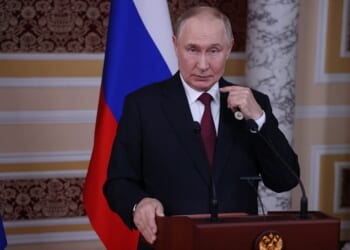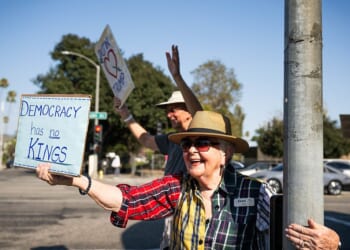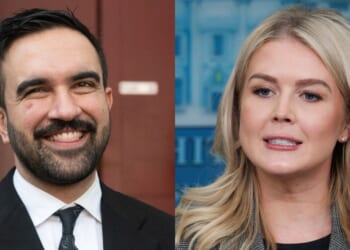Exactly 80 years ago, the trial of the major Nazi war criminals began in Nuremberg — a city symbolically tied to National Socialism as the site of the annual Nazi Party Rally in the Thirties. A panel of judges appointed by the victorious Allies tried 24 Nazi leaders for war crimes and crimes against humanity before the International Military Tribunal.
The trials established for the first time the principle that all governments and their servants are subject to international law. If there was no Nuremberg, there would be no International Criminal Court. Political and military leaders responsible for this century’s genocides would not be brought to justice. Even when they can’t be — as with Putin and Netanyahu, against whom charges have been brought — they are barred from visiting any of the 125 countries that have signed up to the court since its foundation in 2002. But it was far from inevitable that the Nuremberg trials would take place.
Once it became clear that Germany’s defeat was only a matter of time — roughly around the end of 1941, once Hitler had abandoned his plans to invade Britain, and Operation Barbarossa had ground to a halt in the snows of the Russian winter — the Allies were faced with the question of what to do with the Nazi leaders once the war was won. The British, led by Winston Churchill, simply wanted them shot. The Soviet Union preferred a series of show trials, modelled on the rigged and pseudo-legal spectacles mounted by Stalin against his political rivals. It was the United States, however, that advocated a formal trial — one where the defendants would be allowed counsel and proceeding would be as fair as possible, thus demonstrating the superiority of Western legal principles. The British were sceptical about this, because a similar if less elaborate scheme of trials had been brought against the Kaiser and his minions after the First World War had proved to be a fiasco.
But while Western opinion had been deeply sceptical of stories of atrocities committed by the Germans from 1914-18, people had few doubts as to the extent of the Nazis’ crimes. That they were culpable for the outbreak of hostilities in 1939 was virtually undisputed, whilst their responsibility for the deaths of millions of innocent civilians, including over 20 million Soviet citizens and six million Jews from all over Europe, was undeniable. But it was not until August 1945 that the Allies acceded to the American idea of a formal trial.
Many of the Nazis who should have faced these charges had killed themselves in order to avoid facing justice. They included Hitler himself, as well as senior officials including Goebbels and Himmler. But many still remained, from Hermann Göring, the former head of the air force and “second man in the Third Reich”, to Joachim von Ribbentrop, Hitler’s foreign minister. Military leaders including Alfred Jodl and Wilhelm Keitel faced charges of war crimes, while the vicious antisemitic propagandist Julius Streicher stood accused of whipping up the hatreds that lay behind the Holocaust.
Over the following months, a vast amount of evidence was presented to the court. Even the 22 defendants were shocked by film footage shown in the courtroom of concentration camps at the moment of their liberation by Allied troops, with thousands of starving, emaciated prisoners and mountains of rotting corpses. Witnesses testified to the extermination programme carried out at Auschwitz and other camps, as well as the deliberate starvation of more than three million Red Army soldiers taken prisoner by the Germans.
All of this was given wide publicity, including in the Allied-controlled German media, which underlined the trial’s function as a means of educating Germans about the true nature of the Third Reich. And yet despite being offered clear evidence of their crimes, the defendants showed neither remorse nor repentance. They blamed Hitler, or Himmler, or claimed that they had not known these atrocities were happening. Attempts by the defence to highlight what they deemed to be Allied atrocities, such as the carpet-bombing of German cities, which caused more than half a million civilian deaths, were rejected as irrelevant to the proceedings.
The murderous show trials carried out in the Soviet Union in the Thirties on Stalin’s orders presented another problem, particularly since Andrey Vyshynsky, Stalin’s chief prosecutor, was in charge of Soviet preparations for Nuremberg. Moreover, it was the 1939 pact between Nazi Germany and the Soviet Union that had resulted in the Red Army invading eastern Poland, with many thousands of Polish civilians deported to Siberia, and some 22,000 Polish officers and aristocrats murdered by the Soviet secret police at Katyn in early 1940. This too was swept under the carpet in the hope that the Germans would remain the focus of the Tribunal’s attention.
“Despite being offered clear evidence of their crimes, the defendants showed neither remorse nor repentance.”
The verdicts passed by the panel of judges reflected their desire to appear fair. Three of the 24 were acquitted, including Hjalmar Schacht, an economist sidelined by Hitler before the war began. Others, like the architect and armaments minister Albert Speer, were imprisoned for lengthy periods. The main trial was then followed by several other trials, with the Americans forcing German industrialists and doctors to take the stand for crimes committed during the Nazi era. The trial of German judges for their role in condemning many fellow-citizens to death featured in the powerful 1961 movie Judgment at Nuremberg.
Beyond this, there were a large number of trials of lower-level perpetrators, largely forgotten now, but which resulted in the conviction of thousands of war criminals from Poland to Italy, in the countries in which their crimes had been committed. Yet even before these trials were over, real-world politics began to intrude. From 1946 onwards, as the Cold War era emerged, Americans did not want to offend the West Germans in case they succumbed to communism. Sentences passed in war crimes trials were commuted, and many Nazi war criminals were released early. The massive programme of “denazification” was wound down. The need to recruit experienced professionals — doctors, lawyers, teachers — to help rebuild society and its institutions in West Germany meant that many thousands of former Nazis resumed their old positions.
The chief aim of the trials — to lay the foundations of postwar democracy by educating Germans about the crimes of the Nazi era — was met only for a brief time. While three quarters of Germans polled after the Nuremberg trials considered them fair, the figure had fallen to less than half by 1950. It was not until the Jerusalem trial in 1961 of Adolf Eichmann, the main co-ordinator of Holocaust logistics who had been kidnapped by Mossad from his exile in Argentina, and the trial of Auschwitz camp personnel in Frankfurt in the mid-Sixties, that attitudes towards changed. A new determination to deal with the Nazi war criminals began to emerge in West Germany. By this time, the “economic miracle” had convinced West Germans that democracy could deliver prosperity, in contrast to the failure of democracy in the Twenties and early Thirties. Nazism never revived in Germany: the current success of the far-Right is based on anti-immigrant sentiment, not a desire for global conquest.
For all its flaws, the Nuremberg trials established the legitimacy of international criminal law for the future. Of course, just as they fell into the political context of the emerging Cold War in the late Forties, so International Criminal Court rulings today are prey to 21st century power dynamics. The USA opposes any attempt to prosecute its ally, Benjamin Netanyahu, for war crimes in Gaza. Actual trials and verdicts have been held against countries that lack powerful international backing, most notably in Africa, leading to charges of bias. Nevertheless, while politics affect international justice today, just as they did at Nuremberg, the principles established after the Second World War still remain vital to the struggle for peace and humanity. The threat to a rules-based international order posed by Putin and other politicians who have violated fundamental principles of international law still comes up against the principles established at Nuremberg and their articulation by the International Criminal Court and beyond that, world public opinion. That is why we continue to celebrate Nuremberg and its legacy today.

















